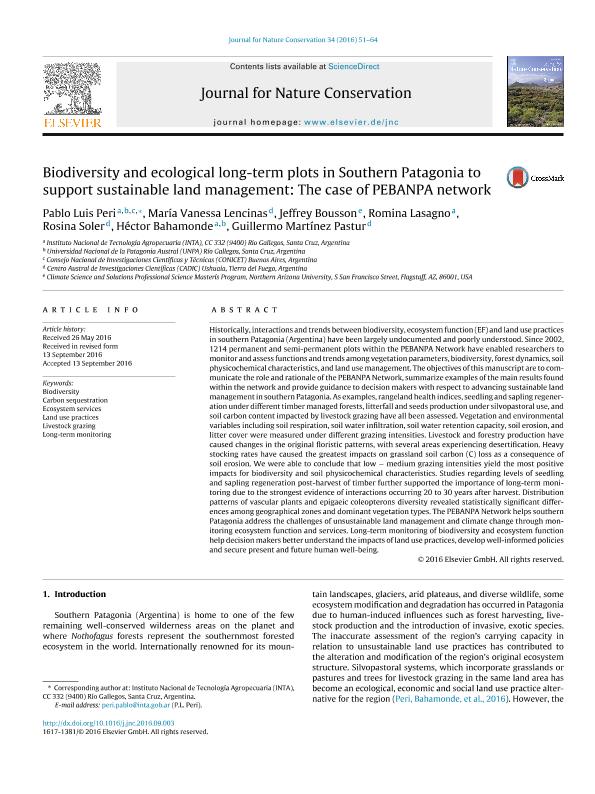Mostrar el registro sencillo del ítem
dc.contributor.author
Peri, Pablo Luis

dc.contributor.author
Lencinas, María Vanessa

dc.contributor.author
Bousson, Jeffrey
dc.contributor.author
Lasagno, Romina
dc.contributor.author
Soler Esteban, Rosina Matilde

dc.contributor.author
Bahamonde, Héctor Alejandro

dc.contributor.author
Martínez Pastur, Guillermo José

dc.date.available
2018-04-05T23:39:31Z
dc.date.issued
2016-12
dc.identifier.citation
Peri, Pablo Luis; Lencinas, María Vanessa; Bousson, Jeffrey; Lasagno, Romina; Soler Esteban, Rosina Matilde; et al.; Biodiversity and ecological long-term plots in Southern Patagonia to support sustainable land management: The case of PEBANPA network; Elsevier Gmbh; Journal For Nature Conservation; 34; 12-2016; 51-64
dc.identifier.issn
1617-1381
dc.identifier.uri
http://hdl.handle.net/11336/41031
dc.description.abstract
Historically, interactions and trends between biodiversity, ecosystem function (EF) and land use practices in southern Patagonia (Argentina) have been largely undocumented and poorly understood. Since 2002, 1214 permanent and semi-permanent plots within the PEBANPA Network have enabled researchers to monitor and assess functions and trends among vegetation parameters, biodiversity, forest dynamics, soil physicochemical characteristics, and land use management. The objectives of this manuscript are to communicate the role and rationale of the PEBANPA Network, summarize examples of the main results found within the network and provide guidance to decision makers with respect to advancing sustainable land management in southern Patagonia. As examples, rangeland health indices, seedling and sapling regeneration under different timber managed forests, litterfall and seeds production under silvopastoral use, and soil carbon content impacted by livestock grazing have all been assessed. Vegetation and environmental variables including soil respiration, soil water infiltration, soil water retention capacity, soil erosion, and litter cover were measured under different grazing intensities. Livestock and forestry production have caused changes in the original floristic patterns, with several areas experiencing desertification. Heavy stocking rates have caused the greatest impacts on grassland soil carbon (C) loss as a consequence of soil erosion. We were able to conclude that low − medium grazing intensities yield the most positive impacts for biodiversity and soil physicochemical characteristics. Studies regarding levels of seedling and sapling regeneration post-harvest of timber further supported the importance of long-term monitoring due to the strongest evidence of interactions occurring 20 to 30 years after harvest. Distribution patterns of vascular plants and epigaeic coleopterons diversity revealed statistically significant differences among geographical zones and dominant vegetation types. The PEBANPA Network helps southern Patagonia address the challenges of unsustainable land management and climate change through monitoring ecosystem function and services. Long-term monitoring of biodiversity and ecosystem function help decision makers better understand the impacts of land use practices, develop well-informed policies and secure present and future human well-being.
dc.format
application/pdf
dc.language.iso
eng
dc.publisher
Elsevier Gmbh

dc.rights
info:eu-repo/semantics/openAccess
dc.rights.uri
https://creativecommons.org/licenses/by-nc-sa/2.5/ar/
dc.subject
BIODIVERSITY
dc.subject
CARBON SEQUESTRATION
dc.subject
ECOSYSTEM SERVICES
dc.subject
LAND USE PRACTICES
dc.subject
LIVESTOCK GRAZING
dc.subject
LONG-TERM MONITORING
dc.subject.classification
Agricultura

dc.subject.classification
Agricultura, Silvicultura y Pesca

dc.subject.classification
CIENCIAS AGRÍCOLAS

dc.title
Biodiversity and ecological long-term plots in Southern Patagonia to support sustainable land management: The case of PEBANPA network
dc.type
info:eu-repo/semantics/article
dc.type
info:ar-repo/semantics/artículo
dc.type
info:eu-repo/semantics/publishedVersion
dc.date.updated
2018-04-03T18:26:15Z
dc.journal.volume
34
dc.journal.pagination
51-64
dc.journal.pais
Alemania

dc.description.fil
Fil: Peri, Pablo Luis. Instituto Nacional de Tecnología Agropecuaria; Argentina. Universidad Nacional de la Patagonia Austral; Argentina. Consejo Nacional de Investigaciones Científicas y Técnicas; Argentina
dc.description.fil
Fil: Lencinas, María Vanessa. Consejo Nacional de Investigaciones Científicas y Técnicas. Centro Austral de Investigaciones Científicas; Argentina
dc.description.fil
Fil: Bousson, Jeffrey. Northern Arizona University; Estados Unidos
dc.description.fil
Fil: Lasagno, Romina. Instituto Nacional de Tecnología Agropecuaria; Argentina
dc.description.fil
Fil: Soler Esteban, Rosina Matilde. Consejo Nacional de Investigaciones Científicas y Técnicas. Centro Austral de Investigaciones Científicas; Argentina
dc.description.fil
Fil: Bahamonde, Héctor Alejandro. Instituto Nacional de Tecnología Agropecuaria; Argentina. Universidad Nacional de la Patagonia Austral; Argentina
dc.description.fil
Fil: Martínez Pastur, Guillermo José. Consejo Nacional de Investigaciones Científicas y Técnicas. Centro Austral de Investigaciones Científicas; Argentina
dc.journal.title
Journal For Nature Conservation

dc.relation.alternativeid
info:eu-repo/semantics/altIdentifier/url/https://www.sciencedirect.com/science/article/pii/S1617138116300826
dc.relation.alternativeid
info:eu-repo/semantics/altIdentifier/doi/http://dx.doi.org/10.1016/j.jnc.2016.09.003
Archivos asociados
